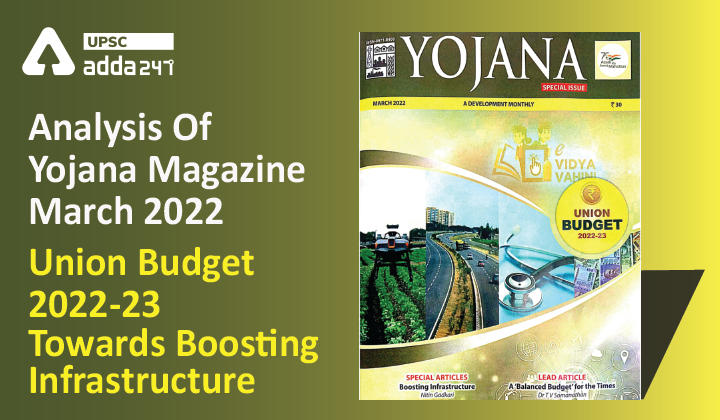Table of Contents
”Union Budget 2022-23 – Towards Boosting Infrastructure”
Relevance
”GS 2: Government Policies & Interventions”
”GS 3: Mobilization of Resources, Government Budgeting, Fiscal Policy”
Introduction
- The government continue on the path to creating world-class infrastructure for economic enhancement and sustainability growth.
- The budget continues to provide an impetus for growth. It lays a parallel track of a blueprint for the Amrit Kaal, which is futuristic and inclusive, which will directly benefit our youth, women, farmers, the Scheduled Castes and the Scheduled Tribes.
- And big public investment for modern infrastructure, readying for India at 100 and this shall be guided by PM GatiShakti and be benefited by the synergy of a multi-modal approach.
- The USD 5 trillion target for our economy is an ambitious one, and the strategy to achieve the same revolves around creating an ecosystem for growth, with its foundation on the creation of infrastructure and Atmanirbhar Bharat.
4 Priorities
Moving forward, on this parallel track the government outlined the following four priorities:
- PM GatiShakti
- Inclusive Development
- Productivity Enhancement & Investment, Sunrise Opportunities, Energy Transition, and Climate Action
- Financing of Investments
What is PM GatiShakti?
- It is a transformative approach for economic growth and sustainable development.
- The approach is driven by seven engines, namely, Roads, Railways, Airports, Ports, Mass Transport, Waterways, and Logistics Infrastructure.
- All seven engines will pull forward the economy in unison.
- These engines are supported by the complementary roles of Energy Transmission, IT Communication, Bulk Water & Sewerage, and Social Infrastructure.
 Finally, the approach is powered by Clean Energy and Sabka Prayas – the efforts of the Central Government, the state governments, and the private sector together – leading to huge job and entrepreneurial opportunities for all, especially the youth.
Finally, the approach is powered by Clean Energy and Sabka Prayas – the efforts of the Central Government, the state governments, and the private sector together – leading to huge job and entrepreneurial opportunities for all, especially the youth.- The Gati Shakti Master Plan aims to expand the national highway framework by 25,000 km between 2022 and 2023, award Multimodal Logistics Park contracts for four locations between 2022 to 2023, integrate railways and postal networks, help local businesses and supply chains through the concept of One Station One Product, develop 400 Indigenous new-generation Vande Bharat trains and set up 100 cargo terminals for enhancing multimodal logistics facilities during the next three years.
National Infrastructure Pipeline (NIP)
- It was launched with a projected infrastructure investment of around Rs. 111 lakh crore during FY 2020-2025 to provide world-class infrastructure across the country and improve the quality of life for all citizens.
- NIP was launched with 6,835 projects, which has expanded to over 9,000 projects covering 34 sub- sectors.
- NIP is a first-of-its-kind, whole-of-government exercise and covers all infrastructure sub-sectors, including MSMEs working in the infrastructure sector, as mentioned in Harmonized Master List of Infrastructure Sub-sectors notified by the Department of Economic Affairs (DEA).
What is PM-DevINE?
A new scheme, Prime Minister’s Development Initiative for NorthEast, PM-DevINE, will be implemented through the North-Eastern Council to fund infrastructure, in the spirit of PM GatiShakti, and social development projects based on felt needs of the North-East.
 An initial allocation of Rs 1500 crore will enable livelihood activities for youth and women, filling the gaps in various sectors.
An initial allocation of Rs 1500 crore will enable livelihood activities for youth and women, filling the gaps in various sectors.
Creation of robust health infrastructure
- The FM announced in the budget that a resilient open platform for the National Digital Health Ecosystem including digital registries of health service providers and facilities, unique health identity, and inclusive access to health facilities would be created.
- Furthermore, a ‘National Tele Mental Health Programme’ will also be launched, equipped with 23 tele-mental health centres of excellence for providing access to mental health counselling.
Way Forward
- The Gati Shakti initiative would help reduce the average logistics cost (as a percentage of GDP).
- Furthermore, the focus on green bonds and various infrastructure investment options would lead infrastructure development towards a sustainable future.
- Inclusive growth, housing for all, quick construction approvals, state partnership for creating enterprises and service hubs, and digitisation would help the real estate sector recover after the pandemic.
- The transformation to a digital India would create many direct and indirect opportunities in the IT space. It would provide significant downstream opportunities for software, hardware, and service companies.
- Digitisation across industries would help create a start-up ecosystem, which would lead to an entrepreneurship wave.
Conclusion
The budget prioritises development over fiscal consolidation in an uncertain economic environment. A sharp growth in capital and infrastructure spending is a crucial factor for achieving a US$ 5 trillion economy. Government spending on key sectors such as housing, infrastructure, defence, and agriculture would have a multiplier effect on the Indian economy.



 TSPSC Group 1 Question Paper 2024, Downl...
TSPSC Group 1 Question Paper 2024, Downl...
 TSPSC Group 1 Answer key 2024 Out, Downl...
TSPSC Group 1 Answer key 2024 Out, Downl...
 UPSC Prelims 2024 Question Paper, Downlo...
UPSC Prelims 2024 Question Paper, Downlo...




